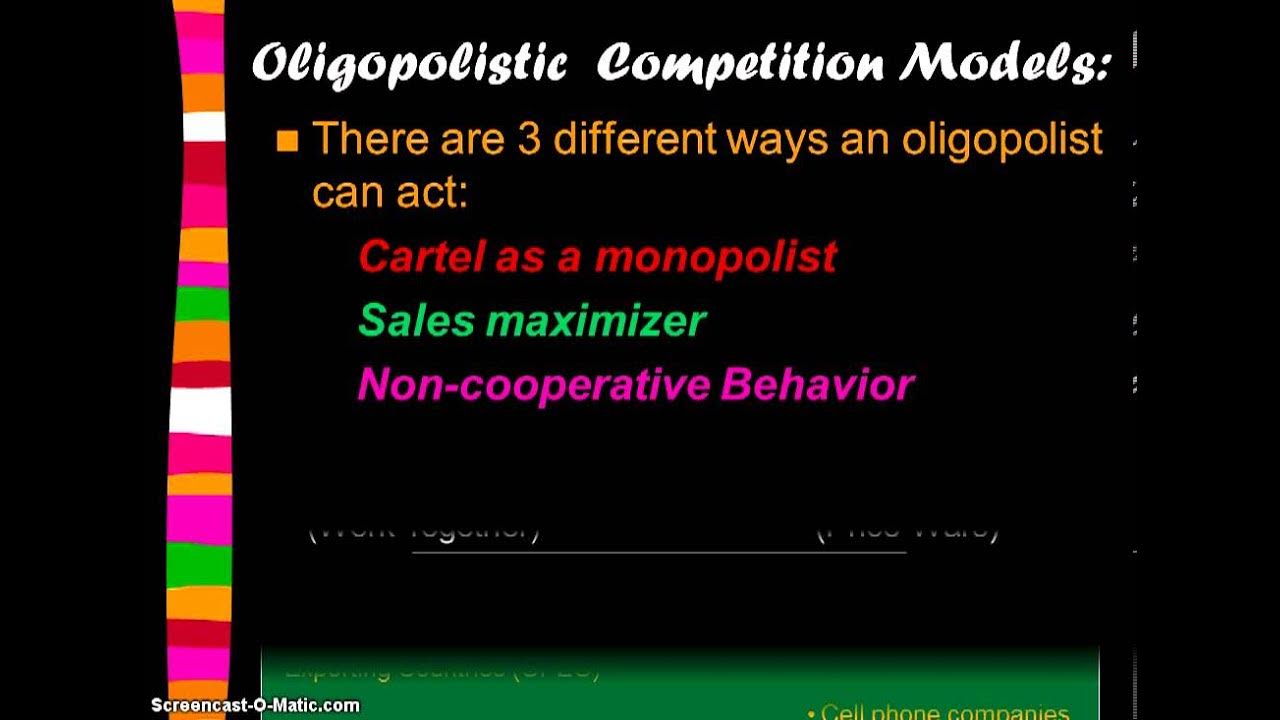Y2/IB 23) Oligopoly - Kinked Demand
Summary
TLDRThis video explains the market structure of oligopoly, where a few large firms dominate the market. It focuses on key characteristics such as high concentration ratios, high barriers to entry, and interdependence between firms. The kinked demand curve theory is explored, illustrating why prices in oligopolistic markets remain rigid due to firms' fear of price wars and loss of market share. Additionally, non-price competition like brand loyalty and advertising is discussed as a strategy for firms to avoid destructive price competition. The video also highlights how firms in such markets consider rivals' likely reactions before making decisions, maintaining price stability and competitive behavior.
Takeaways
- 😀 Oligopoly is a market structure where a few large firms dominate the market, often controlling around 75-80% of market share.
- 😀 Barriers to entry are high in an oligopoly, including high startup costs, capital expenses, and brand loyalty, which prevent new firms from entering.
- 😀 Firms in an oligopoly are interdependent, meaning that decisions made by one firm must consider the likely reactions of rival firms.
- 😀 Oligopoly firms often engage in non-price competition, such as advertising, brand building, and service quality, since price competition can be harmful.
- 😀 The kinked demand curve theory explains price rigidity in oligopoly markets, where firms are reluctant to change prices due to expected reactions from competitors.
- 😀 If a firm raises its price, competitors are likely to lower their prices, causing the firm to lose market share and profits, leading to an elastic demand curve above the price.
- 😀 Conversely, if a firm lowers its price, competitors will likely follow suit, resulting in a price war and reducing profits, leading to an inelastic demand curve below the price.
- 😀 The kinked demand curve suggests that firms in an oligopoly prefer to maintain price stability, as significant price changes are not profitable.
- 😀 Marginal revenue curves in oligopoly markets also exhibit a discontinuity, which further contributes to price rigidity, even in the face of increased costs.
- 😀 Competitive oligopolies often compete on non-price factors like service quality, promotions, and branding to avoid harmful price wars, benefiting consumers without damaging firms.
Q & A
What is an oligopoly market structure?
-An oligopoly is a market structure where a few large firms dominate the market. These firms have significant control over market prices and shares, and their decisions are highly interdependent.
What does a high concentration ratio in an oligopoly indicate?
-A high concentration ratio (typically 75-80%) indicates that a small number of firms control a large portion of the market. This reflects the dominance of a few large firms in the market.
What are some examples of industries that exhibit oligopolistic market structures?
-Examples include the petrol retailing industry, the airline industry, and the banking industry in the UK, where a few large firms dominate the market.
What are the key barriers to entry in an oligopoly?
-Barriers to entry in an oligopoly include high startup costs, capital investment requirements, brand loyalty, and other significant costs that make it difficult for new firms to enter the market.
How does product differentiation affect pricing in an oligopoly?
-Product differentiation allows firms in an oligopoly to have some price-setting power. This means they can influence market prices to an extent, based on their unique product offerings.
What does interdependence mean in the context of an oligopoly?
-Interdependence in an oligopoly means that firms must consider the likely reactions of their competitors when making decisions. Each firm’s actions are closely tied to the expected responses of others in the market.
Why do prices tend to be rigid in an oligopoly?
-Prices in an oligopoly tend to be rigid due to the kinked demand curve theory. If a firm raises its prices, competitors are likely to undercut, leading to lost market share. If a firm lowers its prices, competitors may match or further undercut, leading to a price war.
What is the kinked demand curve theory?
-The kinked demand curve theory suggests that firms in an oligopoly face a demand curve that is more elastic above the prevailing price and inelastic below it. This creates price rigidity because firms are hesitant to change prices for fear of losing market share or starting a price war.
How does the marginal revenue curve relate to price rigidity in an oligopoly?
-The marginal revenue curve in an oligopoly has a discontinuity due to the kinked demand curve. Even if costs increase within a certain range, firms may not change their price, as their profit-maximizing quantity remains the same.
What is the significance of non-price competition in an oligopoly?
-In oligopolies, non-price competition (such as advertising, brand building, and service quality) is more common than price competition. This is because firms seek to avoid damaging price wars, focusing instead on differentiating themselves through factors other than price.
Outlines

This section is available to paid users only. Please upgrade to access this part.
Upgrade NowMindmap

This section is available to paid users only. Please upgrade to access this part.
Upgrade NowKeywords

This section is available to paid users only. Please upgrade to access this part.
Upgrade NowHighlights

This section is available to paid users only. Please upgrade to access this part.
Upgrade NowTranscripts

This section is available to paid users only. Please upgrade to access this part.
Upgrade NowBrowse More Related Video
5.0 / 5 (0 votes)





